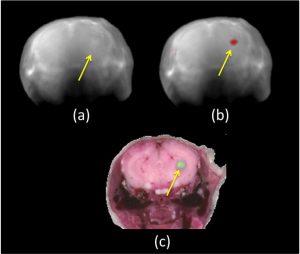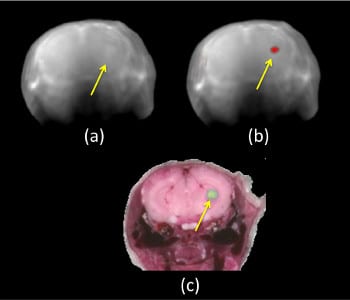Molecular optoacoustic imaging is a powerful tool for research as well as for diagnostics. Multiple excitation wavelengths and appropriate unmixing algorithms have a major impact on sensitivity as compared to single or dual wavelength optoacoustic imaging.
 Optoacoustic imaging is a promising method of non-invasive biomedical imaging which is based on laser-generated acoustic waves for visualizing the internal structure and function of soft tissues. It combines high resolution imaging with sensing of optical contrast and opens up new possibilities for diagnostic or theranostic methods as well as for biological discovery. Its remarkable molecular imaging capabilities relate to the overall ability to reliably resolve the presence of molecules of interest from the absorbing tissue background.
Optoacoustic imaging is a promising method of non-invasive biomedical imaging which is based on laser-generated acoustic waves for visualizing the internal structure and function of soft tissues. It combines high resolution imaging with sensing of optical contrast and opens up new possibilities for diagnostic or theranostic methods as well as for biological discovery. Its remarkable molecular imaging capabilities relate to the overall ability to reliably resolve the presence of molecules of interest from the absorbing tissue background.
In many applications, two or more excitation wavelengths are utilized in order to enhance the contrast of a specific molecule and enable the accurate visualization of its bio-distribution. Multispectral optoacoustic tomography (MSOT) is a novel and powerful imaging modality which offers high resolution optical imaging through several millimeters to centimeters of tissue.
However, the relationship between the number of excitation wavelengths employed and the achieved molecular imaging sensitivity and accuracy has not been established yet. Such a study has been carried out now by scientists from the Helmholtz Zentrum München, the Technische Universität München (Munich, Germany) as well as the Fraunhofer Project Group for Automation in Medicine and Biotechnology (Mannheim, Germany).
A particular complication for studying the relation of wavelength number and multispectral optoacoustic tomography (MSOT) performance is that the MSOT unmixing problem is a complex non-linear and ill-posed open problem. The research group led by Vasilis Ntziachristos formulated this unmixing problem as a molecular target detection problem. They investigated the relative sensitivity achieved using monochromatic, dual wavelength and multispectral optoacoustic tomography as a function of the excitation wavelengths employed.
Based on synthetic MSOT datasets, a statistical quantitative analysis was performed. The datasets were created using target implantation on experimental measurements. The scientists observed a trend of sensitivity increase for up to 20 wavelengths. They quantified this relation and demonstrated an up to one order of magnitude sensitivity increase of multi-wavelength illumination vs. single or dual wavelength optoacoustic imaging. Examples from experimental animal studies were utilized to support the findings.
In follow up studies, exact sensitivity limits under different scenarios shall be established.

















